Australian rules football in England
Australian rules football in England is a team sport and spectator sport with a long history. The current competitions originated in 1989 and have grown to a number of local and regional leagues coordinated by AFL England. In 2018, these regional divisions were the AFL London, AFL Central & Northern England and Southern England AFL.
| Australian rules football in England | |
|---|---|
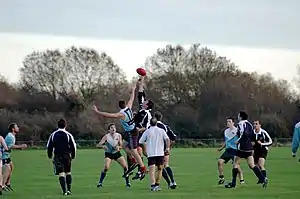 Englands two oldest clubs Cambridge and Oxford Universities (1921) contest centre bounce in 2008 | |
| Country | England |
| Governing body | AFL England |
| National team(s) | England |
| First played | 1888, London |
| Registered players | 3,600 (total) 600 (adult) 3,000 (junior) |
| Clubs | 49 |
Club competitions | |
Audience records | |
| Single match | 18,884 (2005). West Coast v. Fremantle (The Oval, London) |
Australian rules football exhibition matches have been held in London every few years since 1972 and have been well attended.
History of Australian rules football in England
In 1883, during a visit to Australia, English journalist and rugby player Richard Twopeny wrote of Australian Football:
A good football match in Melbourne is one of the sights of the world... The quality of the play... is much superior to anything the best English clubs can produce... there is much more 'style' about the play.[1]
In 1884 H C A Harrison then known then as the "father of Australian Football" visited London where he proposed unifying Australian rules with Rugby under a set of hybrid rules and suggested that rugby clubs adopt some of the Victorian Rules. English football officials expressed their insult at the suggestion that they "abandon their rules to oblige an Antipodean game".[2]
British tours to Australia (1888–1914)
Australian rules football was played by a British representative rugby team which toured Australia in 1888. The team arrived in Hobart, Tasmania on 18 April.[3] They attended a social function with the Southern Tasmanian Football Association, before going to New Zealand for a series of rugby matches.
After they returned to Australia they again trained in Australian rules in Sydney, before leaving for Victoria in mid-June. The tour included 19 matches. They played against several of the stronger football clubs from Melbourne including the Carlton Football Club, South Melbourne Football Club, Essendon Football Club, Fitzroy Football Club and Port Melbourne Football Club. Additionally, they played against some strong regional Victorian clubs including two teams from the city of Ballarat: Ballarat Football Club and Ballarat Imperial Football Club, as well as two teams from the city of Bendigo: Bendigo Football Club and Sandhurst Football Club as well as playing against clubs from other regional towns including the Castlemaine Football Club, Maryborough Football Club, Horsham Football Club and Kyneton Football Club.
The team also played against several of the stronger South Australian teams including South Adelaide Football Club, Port Adelaide Football Club, Adelaide Football Club (no connection to the later Adelaide club), Norwood Football Club. The only club from outside of Victoria or South Australia which played against them was the Maitland Football Club (from the Hunter Region in New South Wales). The British team won six matches, including a win over Port Adelaide at Adelaide Oval on 10 July 1888, and drew one.
The reigning Victorian premiers, Carlton defeated Great Britain at the MCG 14.17 to 3.8. At this stage goals and points were recorded but only goals counted in the score; for example, when Great Britain played Castlemaine under very heavy conditions they kicked 1 goal 2 points and the locals kicked 1 goal 4 points, but the match was declared a draw. Great Britain also played 35 games of rugby, making a total of 54 games in 21 weeks. A star of the team's Australian rules games was Andrew Stoddart, who captained the team for part of its tour and also captained England in cricket.
The 1888 tour had been organised by the English cricketer Arthur Shrewsbury but his involvement with Australian Rules football did not end there. He planned to have an Australian team sent to the United Kingdom to play a series of demonstration matches and to that end he looked to Scotland where he had identified possible opponents. Shrewsbury's plans are outlined in his correspondence with Alfred Shaw and Turner, the Nottingham Cricket Club Secretary.[4]
Introduction of the game in England
Between 1870 and World War I many overseas students studied medicine in Scotland, and some went down to England to play the Australian Rules teams in that country. A scratch match between the Edinburgh Australians against the University of London was planned and then postponed to be held at Balham on 14 April 1888.[5] The match drew considerable praise in UK newspapers such as the Times and the Scotsman.
Shrewsbury suggested that the 'Edinburgh Australians' team at Edinburgh University should travel down to England to meet the Australian team in a series of demonstration matches in Lancashire and Yorkshire. Unfortunately his bold plan did not eventuate as the authorities in Australia aborted the venture and a possible expansion of Australian Rules in the UK was lost.
There were reports from Australia that the game was being played in England between two clubs in 1903[6] and in 1904.[7] By 1906 there were three clubs holding regular competition.[8]
World War I
In 1916, a match was held at the Queen's Club in London between Australian Army teams, representing the Combined Training Units and the 3rd Division, in which many senior Australian rules footballers from all over Australia took part. However, the end of World War I put an end to organised Australian rules competition in England.
Varsity matches between Oxford and Cambridge

After the war, in 1921, the annual Oxford University–Cambridge University Varsity match was played for the first time between expatriate Australian students.[9] This game is still played,[10] and is the longest running Australian rules fixture outside Australia.[11][12] The match is an official Varsity competition. Over the years, some distinguished Australians to have played in the match include Mike Fitzpatrick, Chris Maxwell, Joe Santamaria, Sir Rod Eddington and Andrew Michelmore.[13]
- Men's Results
| Year | Winner | Results | Notes |
|---|---|---|---|
| 1923 | Oxford | Oxford ?.? (80) d Cambridge ?.? (30) | [14] |
| 1925 | Oxford | Oxford 10.17 (77) d. Cambridge 1.11 (17) | [15] |
| 1926 | Cambridge | Cambridge 8.11 (59) d Oxford 8.7 (55) | [16] |
| 1927 | Oxford | Oxford 10.10 (70) d. Cambridge 5.10 (40) | [17] |
| 1928 | Cambridge | Cambridge 11.12 (78) d Oxford 5.10 (40) | [18] |
| 1929 | Oxford | Oxford 9.19 (73) d Cambridge 5.9 (39) | [19] |
| 1930 | Oxford | Oxford 4.4 (28) d Cambridge 4.2 (26) | [20] |
| 1931 | Oxford | Oxford 12.11 (83) d Cambridge 7.5 (47) | [21] |
| 1935 | Oxford | Oxford 9.8 (62) d Cambridge 1.4 (10) | [22] |
| 1949 | Oxford | Oxford 12.6 (78) d Cambridge 3.13 (31) | [23] |
| 1954 | Oxford | Oxford 12.10 (82) d Cambridge 8.10 (58) | [24] |
| 1983 | Cambridge | Cambridge 15.10 (100) d Oxford 7.9 (51) | [25] |
| 2003 | Oxford | Oxford 10.7 (67) d. Cambridge 0.5 (5) | |
| 2004 | Cambridge | Cambridge 3.4 (22) d. Oxford 2.6 (18) | |
| 2005 | Oxford | Oxford 14.15 (99) d. Cambridge 3.4 (22) | |
| 2006 | Oxford | Oxford 32 d. Cambridge 27 | |
| 2007 | Oxford | Oxford 19.11 (125) d. Cambridge 3.10 (28) | Highest ever score recorded |
| 2008 | Oxford | Oxford 8.11 (59) def Cambridge 5.2 (32) | |
| 2009 | Oxford | Oxford 6.15 (51) d. Cambridge 1.1 (7) | |
| 2010 | Oxford | Oxford 17.16 (118) d. Cambridge 9.12 (66) | Highest scoring match to date |
| 2013 | Oxford | Oxford 10.6 (66) d. Cambridge 3.6 (24) | |
| 2014 | Oxford | Oxford 14.6 (90) d. Cambridge 2.2 (14) | |
| 2015 | Cambridge | Cambridge 7.13 (55) d. Oxford 3.4 (22) | |
| 2016 | Oxford | Oxford 9.4 (58) d. Cambridge 7.10 (52) | |
| 2017 | Oxford | Oxford 12.8 (80) d. Cambridge 4.4 (28) | |
| 2018 | Cambridge | Cambridge 4.10 (34) d. Oxford 4.4 (28) | |
In 2018, amid the growth of the sport in England, there was the first ever women's Australian Rules Football Varsity, ending in a tie.
- Women's Results
| Year | Winner | Results | Notes |
|---|---|---|---|
| 2018 | Tie | Oxford 1.1 (7) drew with Cambridge 1.1 (7) | First tie in Australian rules football Varsity history. |
Second World War matches
RAAF (Sunderland) vs RAF Mount Batten was played in 1943 in Plymouth.[26] In November of the same year, a game was played in Sussex between No.11 Personnel despatch and Reception centre team based in Brighton vs RAAF Headquarters from London.[27]
Teams representing RAAF, Headquarters vs Sunderland, met in Hyde Park in 1944 in front of a sizeable crowd. Headquarters defeated Sunderland 12.7 (79) to 5.4 (34).[28]
The first local league
In 1967, Australian expatriates including Michael Cyril Hall and Ted Ford[29] attempted to organise Australian Football in London. Ted engaged high profile expatriate Australians including Rolf Harris, Alan Freeman, Barry Humphries, Neil Hawke, Keith Miller and former Australian prime minister Sir Robert Menzies to support the venture and raise publicity for it. Ford organised a charity match was played in Regent's Park in London, between local club Kensington Demons and established out of town club Oxford University. Athol Guy (who had played VFL reserves wit St Kilda) also made a special appearance as a player. The match also featured England's first all-womens match between Aussie Girls and Wild Colonial Girls as a curtain raiser.[30] The match attracted a crowd of 1,000 spectators.[31] A follow up match between Earl's Court Magpies and Australian Dentists attracted 700 spectators.[31] By May 7 established local teams were ready to form a local league these teams included: Australian Dentists, Australian Navy, Oxford University, Cambridge University, Kensington Demons, Earls Court Magpies and London House.[32] In July, Royal Australian Navy (RAN) personnel played against a combined side drawn from the Earls Court Magpies; Kensington Demons and Australian Dentists in front of a crowd of 1,200 at Regent's Park.[33] RAN personnel would go on to play against local school sides and local rugby clubs.
After some time finding its roots, the Australian National Football League (UK) was formed which by 1970 had six teams, Victorians; Rest of Australia; Portsmouth Naval Base; Plymouth Naval Base; London Gaelic Football Club and Hampstead Rugby Club with matches played in the summer.[34] The later inclusion of two English rugby sides was helping them keep fit in the off-season.[35] Later clubs to play in the league included the Kensington Demons, Earls Court Magpies, Oxford University Blues, Australian Dentists and Australian Navy (based in Portsmouth).[36] This league had disappeared by 1973.
VFL/AFL exhibition matches
In 1972, the first exhibition match of the AFL was played at The Oval in London. Between 1987 and 2006, the game had become an almost annual event, but the only game since then being in 2012. With a large number of ex-patriate Australians, interest in the game grew and small crowds of up to 10,000 were in attendance for the event in some years. Interest and crowds grew further with the change of the VFL to the Australian Football League. Highlights during this time included large crowds for the Australian Football League's West Coast Eagles v. Collingwood in 1997 with an attendance of 14,000 and the match between Richmond and Essendon in 2002 which drew 13,000.
The British Australian rules football league
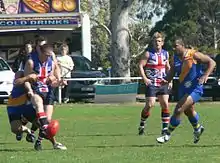
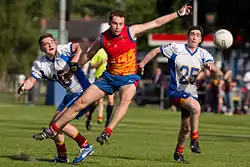
In 1989 the British Australian rules football League (BARFL) was formed. Serious competition began and the competition became more popular, with the local BARFL Grand Finals becoming a large event attracting attendances in the thousands, including a record crowd of 1,500 in 1999.
In 2002 a national team represented Great Britain at the Australian Football International Cup for the first time, finishing the tournament in 6th place. 2005 saw the British Bulldogs again compete in the International Cup, again finishing 6th overall.
Following the 2005 International Cup, promising 22-year-old British Bulldog Luke Matias began playing with the Port Melbourne Football Club in the Victorian Football League.
Also in 2005, the first Western Derby to be played outside of Australia, the West Coast Eagles v. Fremantle game was played as a pre-season test at The Oval in London, drawing a record crowd of 18,884.
Emergence of Aussie rules UK
In 2005 the first junior development program, Aussie Rules Schools, commenced. The program, co-ordinated by the new development body Aussie Rules UK, part of Aussie Rules International was kicked off. This project has seen up to 10 English schools adopt Aussie Rules as part of the school curriculum to combat obesity. Juniors teams have competed at the London Youth Games.
2006 was a big year for Aussie Rules in England, with the admission of new clubs in Manchester, Middlesbrough and Thanet.
On 17 September 2006 history was made in Denmark when the England Dragonslayers took on the Denmark Vikings in Europe's first fully-fledged international junior Aussie Rules match. England claimed the King Canute Cup, with England 6.10(46) defeating Denmark 0.6(6).[37]
In July 2007, the AFL announced that the annual London exhibition match was likely to be abandoned for the year, after only the Western Bulldogs had expressed interest.
In a first in 2007, the GB Bulldogs including several past and future England players, soundly defeated Ireland in Dublin 11.15(81) to 2.9(21).
AFL Britain
In 2008, a resolution to the divide between the two competing leagues saw a single national body, AFL Britain form, which formally affiliated to the AFL. The BARFL was dissolved and became AFL London, while regional leagues including the Scottish Australian Rules Football League and the Welsh Australian Rules Football League affiliated with the new national body.
AFL England
In 2012, AFL England was formed as the national governing body for Australian rules football in England, separate to AFL Scotland and AFL Wales.
Participation
In 2004, there were a total of around 435 senior players across 18 clubs in England. The local league has a higher number of ex-patriate Australians compared to other countries that participate in the sport, however the league recently put in place caps on the number of expatriate players in certain divisions to improve the mix and encourage more local players.
By the end of 2007, the game had experienced substantial growth due to the placement of permanent development officers. AFL International Census figures indicate over 3,600 participants[38]
Audience
Television
Australian rules football is regularly shown on BT Sport.
Local competitions
1,500 (1999). BARFL Grand Final. West London Wildcats vs Wandsworth Demons. London[39]
Exhibition match
18,884 (2005). West Coast v. Fremantle (The Oval, London)
National teams
AFL England currently manages four national teams. The Great Britain Bulldogs and Great Britain Swans compete every three years at the International Cup in Melbourne. The squad is made up of players mainly from the London clubs, however they are often joined by players competing in Australia. In 2017 the Bulldogs finished sixth, their joint-highest finish, while in their maiden year the Swans finished third, defeating the United States 5.2 (32) to 4.1 (25)
The English teams are known as the England Dragonslayers and the England Vixens. Both teams won the AFL Europe Euro Cup in 2017.[40] In 2018, the Vixens finished runners-up
London
| Club | Years in competition | Conference Team | Social Team | Previous names |
|---|---|---|---|---|
| Earls Court Kangaroos | 1990–97 | Esher Kangaroos (1992), Firkin Roos (1996–97) | ||
| North London Lions | 1990- | Regent's Park Lions | Bounds Green | |
| Putney Magpies | 1999- | Hammersmith Magpies | Fulham Magpies | London Gryphons (1999–2003), merged with London Collingwood Supporters' Group |
| Lea Valley Saints | 1990–96 | |||
| London Swans | 1991- | City Swans | Sussex Swans (1991–2007), name still used for their ARUK Southern team | |
| Thames Valley Magpies | 1990–91 | |||
| South East London Giants | 2008- | Dulwich Dragons (2008–2011) | ||
| Wandsworth Demons | 1990- | Clapham Demons | South London Demons | |
| West London Wildcats | 1990- | Shepherds Bush Raiders | Ealing Emus | |
| Wimbledon Hawks | 1990- | Fulham Hawks | London Hawks (1990–94) |
Regional England
| Club | Leagues competed in | Other names |
|---|---|---|
| Birmingham Bears | ARUK Central Division (2009) | |
| Birmingham Crows | BARFL (1993–94) | |
| Bournemouth Demons | ARUK Southern Division (2007–11) | |
| Brighton Black Swans | ARUK Southern Division (2007–08) | |
| Bristol Dockers | BARFL (1991–2002), BARFL Regional (2003–06), AFL London Social League (2007-) | Bristol Bears (1991–96) |
| Chippenham Redbacks | ARUK Southern Division (2008–09) | |
| Doncaster Saints | BARFL Regional (2003–04) | |
| Durham Saints | ARUK Northern Division (2007–09) | Durham Swans (2007–08) |
| East Midland Eagles | BARFL (1990–96) | |
| Gateshead Miners | ARUK Northern Division (2009) | |
| Guildford Crows | ARUK Southern Division (2011) | |
| Hartlepool Dockers | ARUK Northern Division (2007–09) | |
| Huddersfield Rams | ARUK Central Division (2009) | |
| Leeds Bombers | ARUK Central Division (2009) | |
| Liverpool Blues | BARFL (1993–94) | |
| Liverpool Eagles | ARUK Central Division (2009) | |
| Manchester Mosquitoes | BARFL Regional (2006), AFL London Social League (2007–09) | |
| Middlesbrough Hawks | SARFL (2006), ARUK Northern Division (2007–09) | |
| Newcastle Centurions | ARUK Northern Division (2007–09) | |
| Nottingham Scorpions | BARFL Regional (2004–06), AFL London Social League (2007–09) | |
| Plymouth Lions | Plymouth Seagulls (2011) | |
| Portsmouth Pirates | ARUK Southern Division (2009) | |
| Reading Kangaroos | BARFL Regional (2003–06), AFL London Social League (2007–09) | |
| Sheffield Thunder | ARUK Central Division (2009) | |
| Southampton Titans | ARUK Southern Division (2007–09) | |
| St Helens Miners | BARFL (2002–04) | Northwestern Miners (2004) |
| Sussex Swans | BARFL (1991-), ARUK Southern Division (2007–09) | |
| Swindon Devils | BARFL Regional (2004–06), WARFL (2007) | |
| Thanet Bombers | BARFL Regional (2006), ARUK Southern Division (2007) | Thanet Bombardiers (2006) |
Juniors
- Clapham Cubs
Players
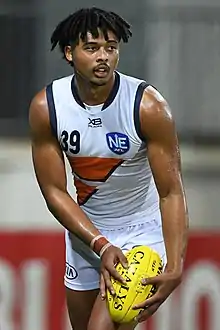 Connor Idun playing for Greater Western Sydney in 2019
Connor Idun playing for Greater Western Sydney in 2019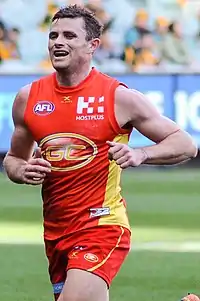 Pearce Hanley playing for the Gold Coast in 2017
Pearce Hanley playing for the Gold Coast in 2017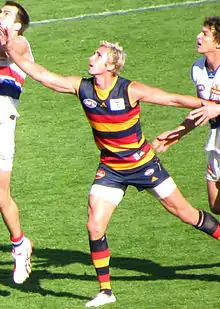 Brad Moran playing for Adelaide in 2009
Brad Moran playing for Adelaide in 2009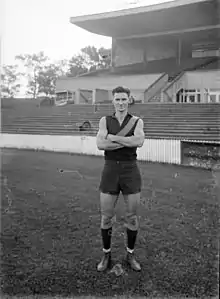 Polly Perkins playing for Richmond in 1948
Polly Perkins playing for Richmond in 1948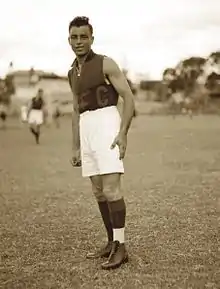 Johnny Lennon playing for Subiaco in 1926
Johnny Lennon playing for Subiaco in 1926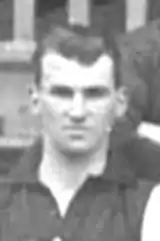 Ted Brewis of Carlton in 1926
Ted Brewis of Carlton in 1926
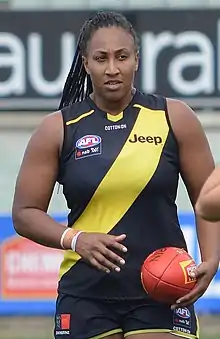 Sabrina Frederick playing for Richmond in 2020
Sabrina Frederick playing for Richmond in 2020
| Currently on an AFL senior list |
| Currently on an AFLW senior list |
| Player | Club/s | VFL/AFL Years* | VFL/AFL Matches* | Connections to the UK, References |
|---|---|---|---|---|
| Katrina Stone | Western Bulldogs, Carlton Football Club (VFLW) | - | - | Recruited from the North London Lions (AFL London) |
| Sabrina Frederick | Brisbane, Richmond, Collingwood | 2017– | 38 | Born, mother[55] |
- as of 2019 AFLW season
External links
- Surrey Cricket AFL annual exhibition match at 'The Oval'
- AFL Britain website
- BARFL website
- ARUK National League
- Aussie Rules UK
- Cambridge University Australian Rules Football Club
- Oxford University Australian Rules Football Club
- Video of Aussie Rules from YouTube
- The Birmingham Bears
- sports on ESPN UK link.
- subscribe to ESPN UK link.
References
- R. Twopenny, Townlife in Australia, Melbourne 1977 (1883), pp. 207–8
- AUCKLAND STAR, VOLUME XXVI, ISSUE 4533, 9 DECEMBER 1884, PAGE 2
- "THE MERCURY". The Mercury. Hobart, Tasmania. 19 April 1888. p. 2. Retrieved 14 July 2011 – via National Library of Australia.
- Letter from Shrewbury to Alfred Shaw. 'Football's Forgotten Tour' (p50)
- "Our Anglo-Colonial Letter". The Express And Telegraph. Vol. XXV, no. 7, 327. South Australia. 17 May 1888. p. 2. Retrieved 24 November 2021 – via National Library of Australia.
- "THE "AUSTRALIAN" GAME OF FOOTBALL". The Daily Telegraph. No. 7769. New South Wales, Australia. 29 April 1904. p. 3. Retrieved 27 October 2021 – via National Library of Australia.
- "AUSTRALIAN FOOTBALL". The Australian Star. No. 5417. New South Wales, Australia. 24 June 1905. p. 8 (FIRST EDITION). Retrieved 30 September 2021 – via National Library of Australia.
- "AUSTRALIAN FOOTBALL". The Australian Star. No. 5726. New South Wales, Australia. 21 June 1906. p. 4 (FIRST EDITION). Retrieved 27 October 2021 – via National Library of Australia.
- "Aussie Rules' history in UK - in just 250 words Archived 22 August 2006 at archive.today"
- "Oxford vs Cambridge, Aussie Rules, 23/2/2002 Archived 15 December 2005 at the Wayback Machine"
- AFL.com.au: Four quarters decides 1000-year rivalry, 12/1/2010 Archived 17 June 2010 at the Wayback Machine
- Triumphant Oxford are rucking great Archived 20 August 2007 at the Wayback Machine from oxfordstudent.com
- "Archived copy". Archived from the original on 26 September 2012. Retrieved 8 February 2014.
{{cite web}}: CS1 maint: archived copy as title (link) - The Argus, 13 April 1923
- The Argus, 25 November 1925
- The Argus, 27 November 1926
- The Argus, 30 November 1927
- The Argus, 23 November 1928
- The Mercury, 16 November 1929
- The Argus, 28 November 1930
- The Argus, 20 November 1931
- The Advertiser, 11 November 1935
- The Canberra Times, 5 December 1949
- The Times (London), 22 November 1954
- The Times (London), 3 December 1983
- "Australian pictures in Trove". Trove.
- Australian War Memorial UK0742
- Australian War Memorial UK0900
- 'The Footy World Magazine', Wednesday 5 July 1967, pp 12-13
- "Now it's Rules Britannia". The Canberra Times. Vol. 41, no. 11, 728. Australian Capital Territory, Australia. 30 June 1967. p. 14. Retrieved 7 December 2021 – via National Library of Australia.
- London footy, '60s style! by John Delvaney for Australian Football.com
- "Londoners to watch Rules". The Canberra Times. Vol. 41, no. 11, 678. Australian Capital Territory, Australia. 2 May 1967. p. 16. Retrieved 7 December 2021 – via National Library of Australia.
- "Rules was popular". The Canberra Times. Vol. 41, no. 11, 731. Australian Capital Territory, Australia. 4 July 1967. p. 14. Retrieved 7 December 2021 – via National Library of Australia.
- "Black swans by the Thames". The Canberra Times. Vol. 45, no. 12, 712. Australian Capital Territory, Australia. 2 October 1970. p. 18. Retrieved 7 December 2021 – via National Library of Australia.
- Obituary throws up questions about British footy history from worldfootynews.com
- London Footy Sixties Style Archived 29 August 2007 at the Wayback Machine from fullpointsfooty.com
- Aussie Rules - England defeat Denmark Archived 25 July 2011 at the Wayback Machine
- AFL International Census 2007 Archived 24 May 2011 at the Wayback Machine
- "Instant Loans - Iafc". www.iafc.com.au.
- "England Dragonslayers – AFL England". www.aflengland.org.
- Brian Clarke (2003). "Overseas Born VFL/AFL players". International Australian Football Council. Retrieved 15 May 2012.
- Rugari, Vince (2 August 2019), "Cameron's calf injury opens derby door for Giants debutant", The Age
- https://www.aflq.com.au/queensland-clubs-celebrate-diversity/ AFL Queensland clubs celebrate diversity
- Trantino, Julian (30 July 2020). "Draper to make debut". EssendonFC Media. Retrieved 23 August 2020.
- Colangelo, Anthony (30 July 2020). "Trade-target ruck Draper to debut for Essendon". The Age. Retrieved 23 August 2020.
- Quayle, Emma (2 October 2003). "Watts not to like about draftee from Dragons". The Age. Melbourne.
- "Our brightest stars: Subiaco District".
- "Carlton's International XVIII".
- "Carlton's International XVIII".
- "Carlton's International XVIII".
- "Carlton's International XVIII".
- "Carlton's International XVIII".
- "Carlton's International XVIII".
- "Carlton's International XVIII".
- "Sabrina doing what she loves", The West Australian, 16 March 2016. Retrieved 19 February 2017.
|}